1 Crown Isle of Man Copper/Nickel Elizabeth II (1926-2022)
1970, Isle of Man (British Dependency), Elizabeth II. Cu-Ni Crown Coin.
Mint Year: 1970 Reference: KM-18. Denomination: Crown - Manx Cat Material: Copper-Nickel Diameter: 38.5mm Weight: 28.25gm
The Manx cat (/ˈmæŋks/, in earlier times often spelled Manks) is a breed of domestic cat (Felis catus) originating on the Isle of Man, with a naturally occurring mutation that shortens the tail. Many Manx have a small stub of a tail, but Manx cats are best known as being entirely tailless; this is the most distinguishing characteristic of the breed, along with elongated hind legs and a rounded head. Manx cats come in all coat colours and patterns, though all-white specimens are rare, and the coat range of the original stock was more limited. Long-haired variants are sometimes considered a separate breed, the Cymric. Manx are prized as skilled hunters, and thus have often been sought by farmers with rodent problems, and been a preferred ship’s cat breed. They are said to be social, tame and active. An old local term for the cats on their home island is stubbin. Manx have been exhibited in cat shows since the 1800s, with the first known breed standard published in 1903.
em>.
The Isle of Man (Manx: Ellan Vannin), sometimes referred to simply as Mann (/mæn/; Manx: Mannin [ˈmanɪn]), is a self-governing British Crown dependency in the Irish Sea between Great Britain and Ireland. The head of state is Queen Elizabeth II, who holds the title of Lord of Mann and is represented by a Lieutenant Governor. Defence is the responsibility of the United Kingdom. Insurance and online gambling generate 17% of GNP each, followed by information and communications technology and banking with 9% each. The island has been inhabited since before 6500 BC. Gaelic cultural influence began in the 5th century AD, and the Manx language, a branch of the Gaelic languages, emerged. In 627, Edwin of Northumbria conquered the Isle of Man along with most of Mercia. In the 9th century, Norsemen established the Kingdom of the Isles. Magnus III, King of Norway, was King of Mann and the Isles between 1099 and 1103. In 1266, the island became part of Scotland under the Treaty of Perth, after being ruled by Norway. After a period of alternating rule by the kings of Scotland and England, the island came under the feudal lordship of the English Crown in 1399. The lordship revested into the British Crown in 1765, but the island never became part of the 18th-century Kingdom of Great Britain or its successors the United Kingdom of Great Britain and Irelandand the present-day United Kingdom. It retained its internal self-government.
For centuries, the island’s symbol has been the so-called “three legs of Mann” (Manx: Tree Cassyn Vannin), a triskelion of three legs conjoined at the thigh. The Manx triskelion, which dates back with certainty to the late 13th century, is of uncertain origin. It has been suggested that its origin lies in Sicily, an island which has been associated with the triskelion since ancient times.
The symbol appears in the island’s official flag and official coat of arms, as well as its currency. The Manx triskelion may be reflected in the island’s motto, Latin: Quocunque jeceris stabit, which appears as part of the island’s coat of arms. The Latin motto translates into English as “whichever way you throw, it will stand” or “whithersoever you throw it, it will stand”. It dates to the late 17th century when it is known to have appeared on the island’s coinage. It has also been suggested that the motto originally referred to the poor quality of coinage which was common at the time—as in “however it is tested it will pass”.
(3205 X 1555pixels, file size: ~772K)
Posted by: anonymous 2024-03-19
ISLE OF MAN 1 Crown 1970 - Copper-Nickel - Manx Cat - Elizabeth II. - aUNC -656*
(1537 X 727pixels, file size: ~216K)
Posted by: anonymous 2018-09-16
Untitled Document 1970, Isle of Man (British Dependency), Elizabeth II. Cu-Ni Crown Coin. AU-UNC! Mint Year: 1970 Reference: KM-18. Denomination: Crown - Manx Cat Condition: A nice AU-UNC in original plastic box of issue! Material: Copper-Nickel Diameter: 38.5mm Weight: 28.25gm Th ...
1 Histamenon Byzantine Empire (330-1453) Gold Constantine IX ...
group has 2 coins
⇑
50000 Peso Uruguay Silver
group has 2 coins / 1 prices
⇑










-300-150-RGXBwcI0BYwAAAEmAvA6TOhH.jpg)








